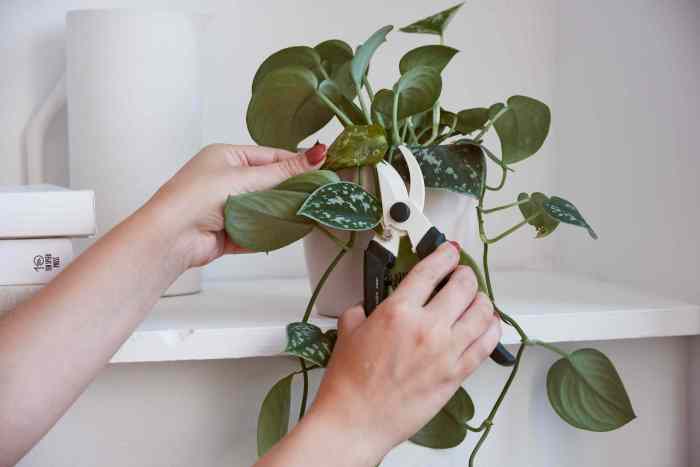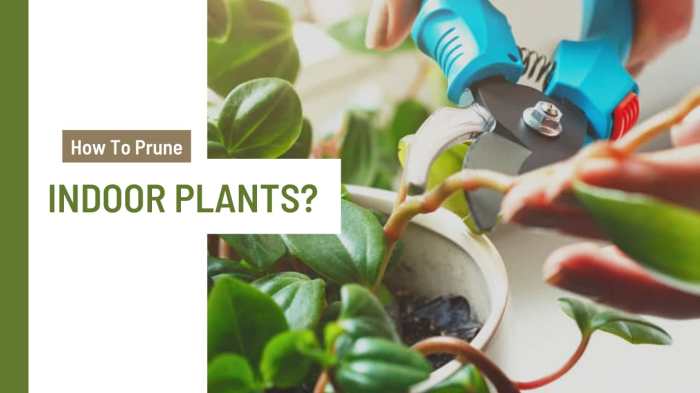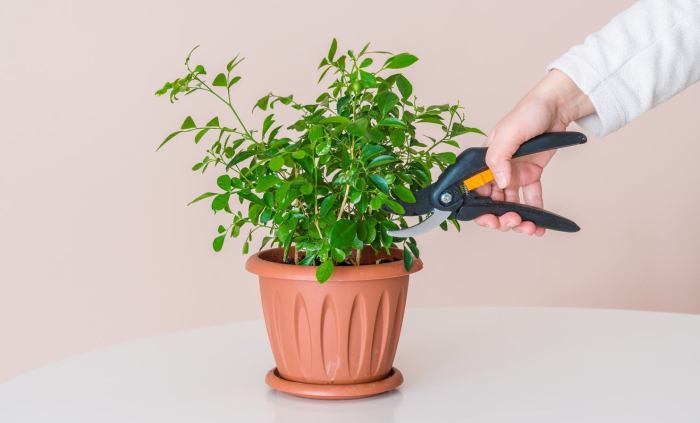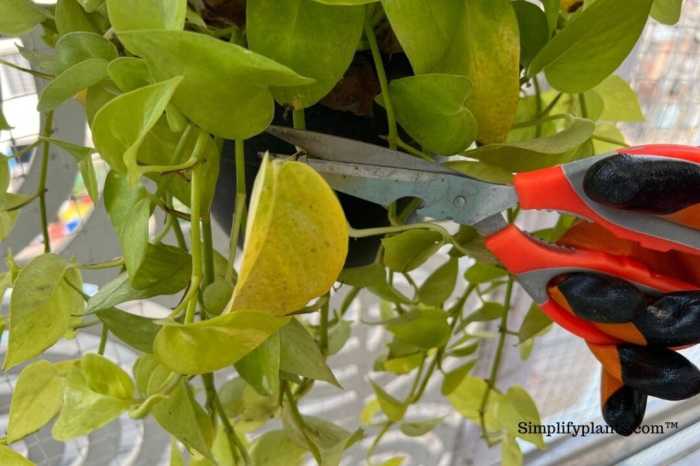How to trim indoor plants – Embark on a journey of plant care mastery with our comprehensive guide to trimming indoor plants. Discover the transformative benefits of pruning, from promoting healthy growth to enhancing aesthetics. Learn expert techniques for shaping, removing dead foliage, and troubleshooting common issues.
Whether you’re a seasoned plant enthusiast or a novice seeking to nurture your indoor oasis, this guide will equip you with the knowledge and skills to cultivate thriving greenery.
By understanding the specific needs of different plant types and employing the appropriate trimming methods, you’ll unlock the secrets to maintaining vibrant and flourishing indoor plants that bring joy and vitality to your living space.
Introduction to Indoor Plant Trimming

Trimming indoor plants is an essential part of their care, offering numerous benefits. It promotes healthy growth by removing dead or diseased leaves and stems, allowing the plant to focus its energy on new growth. Regular trimming also enhances the plant’s aesthetics, creating a more balanced and visually appealing appearance.
Additionally, it helps control the size and shape of the plant, preventing it from becoming overgrown or unwieldy.
Choosing the Right Tools
Selecting the appropriate tools for trimming indoor plants is crucial. Sharp, clean shears or scissors are essential for making precise cuts without damaging the plant tissue. For larger plants or thicker stems, pruning shears or loppers may be necessary. Additionally, a sharp knife can be useful for removing diseased or damaged roots.
Techniques for Trimming Indoor Plants
Trimming indoor plants is an essential part of their care, promoting healthy growth, preventing disease, and enhancing their aesthetic appeal. There are several different trimming techniques that can be used, each with its own advantages and disadvantages.
Pinching, How to trim indoor plants
Pinching is a technique used to remove the growing tip of a stem, encouraging the plant to produce more lateral branches. This results in a fuller, bushier plant. Pinching is best done on young, actively growing plants. To pinch a plant, simply use your thumb and forefinger to gently squeeze the growing tip, removing the top 1-2 inches of the stem.
Pruning
Pruning is a more severe form of trimming that involves removing entire stems or branches from a plant. Pruning is used to control the size and shape of a plant, remove dead or damaged growth, and encourage new growth. To prune a plant, use sharp, clean shears to cut stems at a 45-degree angle, just above a leaf node.
Trimming indoor plants is essential for maintaining their health and appearance. By removing dead or damaged leaves and stems, you can promote new growth and prevent disease. Hibiscus plants, a popular choice for indoor gardens, require specific trimming techniques to encourage flowering and maintain their shape.
For detailed instructions on how to trim hibiscus plants, refer to the comprehensive guide at how to trim hibiscus plants . Proper trimming practices not only enhance the beauty of indoor plants but also contribute to their overall well-being.
Pruning can be done at any time of year, but it is best done during the dormant season when the plant is not actively growing.
Shearing
Shearing is a technique used to trim the outer edges of a plant, creating a more formal, manicured look. Shearing is best done on plants with dense, leafy growth, such as hedges or topiaries. To shear a plant, use sharp, clean shears to trim the outer edges of the plant, following the desired shape.
Shearing can be done at any time of year, but it is best done during the growing season when the plant is actively growing.
Removing Dead or Damaged Leaves and Stems
It is important to regularly remove dead or damaged leaves and stems from indoor plants. Dead or damaged leaves and stems can provide a breeding ground for pests and diseases, and they can also make the plant look unsightly. To remove dead or damaged leaves and stems, simply use sharp, clean shears to cut them off at the base.
Specific Considerations for Different Plant Types
Trimming indoor plants requires an understanding of their specific needs. Different plant types have unique growth habits and natural shapes that influence how they should be trimmed.
Consider the following guidelines for common indoor plant types:
Succulents
Succulents, known for their fleshy leaves and stems, require minimal trimming. Remove dead or damaged leaves, and trim any offsets or pups that become too large or crowded.
Ferns
Ferns have delicate fronds that can become overgrown or damaged. Trim any brown or yellowing fronds, and remove any dead or diseased fronds.
Trimming indoor plants can be a simple task with the right techniques. One specific type of indoor plant that requires special attention is the hydrangea. For those looking to master the art of hydrangea trimming, this guide provides step-by-step instructions to ensure healthy and beautiful hydrangeas.
Remember, proper trimming techniques not only enhance the appearance of your indoor plants but also promote their overall health and longevity.
Flowering Plants
Flowering plants benefit from regular trimming to encourage blooming and maintain a compact shape. Deadhead spent flowers, and trim back stems to promote new growth and flowering.
Troubleshooting Common Trimming Issues

Trimming indoor plants can be a rewarding task, but it’s not without its challenges. Common problems that may arise during plant trimming include over-trimming, improper cuts, and inadequate aftercare. Addressing these issues promptly is crucial for maintaining plant health and preventing future problems.
Over-Trimming
Over-trimming occurs when too much foliage is removed from the plant. This can weaken the plant, stunt its growth, and make it more susceptible to pests and diseases. To avoid over-trimming, it’s important to trim only the necessary amount of foliage and to make cuts at strategic locations.
Improper Cuts
Improper cuts can damage plant tissues and create entry points for pathogens. When trimming, always use sharp, clean shears and make clean, precise cuts. Avoid tearing or crushing the plant tissues.
Inadequate Aftercare
After trimming, it’s important to provide proper aftercare to help the plant recover and thrive. This includes watering the plant thoroughly, providing it with adequate light, and monitoring it for any signs of stress or disease.Regular maintenance and follow-up care are essential for keeping trimmed plants healthy.
Trimming indoor plants is essential for their health and aesthetics. When trimming, consider the specific needs of each plant. For instance, rubber plants require regular pruning to maintain their shape and promote healthy growth. Learn more about how to trim rubber plants at how to trim rubber plants . By following these tips, you can ensure that your indoor plants thrive and enhance your living space.
Inspect your plants regularly for any signs of overgrowth or damage, and trim as needed to maintain their desired shape and size.
Advanced Trimming Techniques: How To Trim Indoor Plants

Beyond basic trimming, advanced techniques like topiary and bonsai offer creative ways to shape and style indoor plants. These techniques require specialized tools, materials, and patience, but the results can be stunning.
Topiary
Topiary involves shaping plants into specific forms, such as animals, geometric shapes, or abstract designs. To create topiary, you’ll need sharp shears, a template, and a wire frame to guide your trimming. Start by outlining the desired shape on the template, then use the wire frame to secure the branches into place.
Trim the foliage carefully, following the template and removing any excess growth.
Bonsai
Bonsai is the ancient Japanese art of cultivating miniature trees in containers. Bonsai techniques aim to create the illusion of a mature tree in a small space. To create bonsai, you’ll need specialized tools like concave cutters, root rakes, and wire.
Start by selecting a healthy plant and pruning its roots to encourage a compact root system. Wire the branches to shape them, and trim the foliage to create a desired canopy. Regular watering, fertilizing, and repotting are essential for maintaining bonsai.
Final Thoughts

With the techniques Artikeld in this guide, you’ll become a confident plant trimmer, empowered to create a thriving indoor ecosystem. Remember, regular maintenance and follow-up care are essential to ensure your plants continue to flourish. Embrace the art of indoor plant trimming, and witness the transformative power it brings to your home and well-being.
Query Resolution
Q: What are the benefits of trimming indoor plants?
A: Trimming promotes healthy growth, improves aesthetics, controls size, and removes dead or damaged foliage.
Q: What tools are essential for trimming indoor plants?
A: Sharp shears, pruning snips, and a sterile blade are essential tools for precise and clean cuts.
Q: How often should I trim my indoor plants?
A: The frequency of trimming depends on the plant type and growth rate. Generally, trim when new growth emerges or when the plant becomes overgrown.
Q: Can I trim all indoor plants the same way?
A: No, different plant types have specific trimming needs. Research the specific requirements of your plants before trimming.
Q: What are some common mistakes to avoid when trimming indoor plants?
A: Avoid over-trimming, improper cuts, and trimming at the wrong time of year. Always use sharp tools and sterilize them before use.